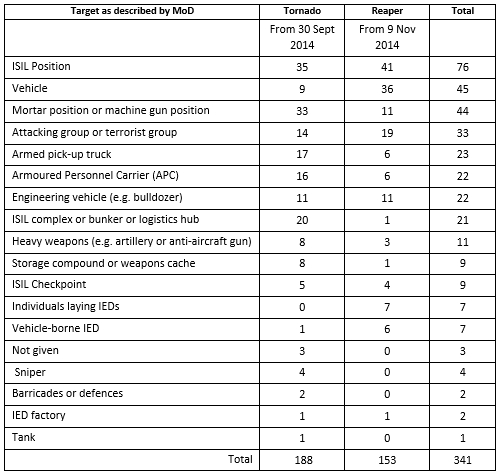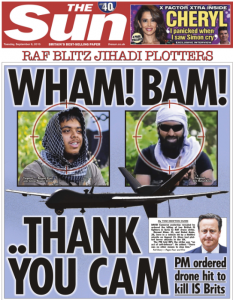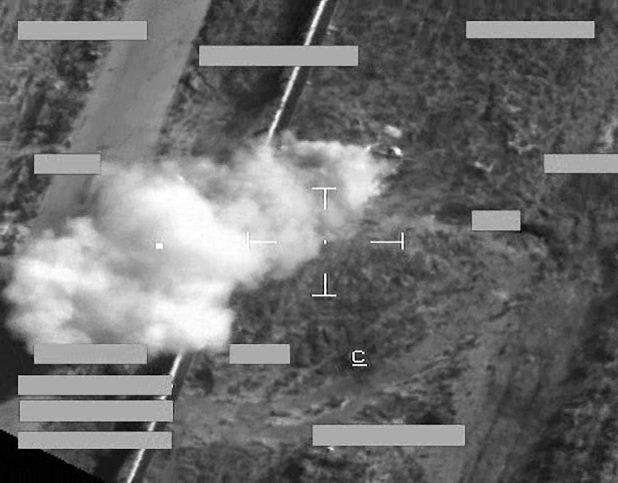British manned and unmanned aicraft have carried out at least 324 airstrikes against Islamic State in their first year of operations, according to an Airwars assessment of Ministry of Defence reports.
The attacks – second only to the United States in number – have killed hundreds of Daesh fighters, the MoD says. Officials also insist that no civilian has died in British attacks – a claim greeted with skepticism by some analysts.
Britain became the seventh member of the international Coalition to carry out anti-Daesh strikes, when on September 30th 2014 a pair of RAF Tornados targeted “an ISIL heavy weapon position which was engaging Kurdish ground forces. One Paveway IV guided bomb was used to attack the ISIL position.” The aircraft then went on to destroy a nearby truck.
Channel 4 News captures a British Tornado strike on camera
October 1st 2014
The following day, Jonathan Rugman of Britain’s Channel 4 News watched as two RAF Tornados destroyed an ISIL stronghold at the border town of Rabia. As he noted at the time: “The building shook and billowed smoke and fire. The Kurds told each other how marvellous this was – and then they told me how grateful they were for foreign air support. These men appear lamentably short of weapons and training, but now they have friends in high places that their enemy does not.”
But Rugman also urged caution at the MoD’s insistence no civilians had died, noting: “We don’t know if there were civilian casualties: the peshmerga said they feared the jihadists had forced women to accompany them as human shields.”
Those first British strikes came just days after Parliament voted to begin attacks in Iraq – though not in Syria. As Defence Secretary Michael Fallon said at the time: “Halting the advance of ISIL and helping the Iraqi government turn it back, and helping the Iraqi army and Kurdish forces to do that, is a huge task and is going to be a long campaign.”
All British strikes were initially carried out by the RAF’s ageing 30-year old Tornado manned aircraft, flying out of Akrotiri in Cyprus. Much of that fleet was due for retirement in 2015 – though some squadrons will now continue in service until at least 2017.
Heavy drone use
Britain’s 10-strong fleet of Reaper unmanned drones began surveillance-only operations in Iraq on October 22nd 2014. Despite Parliament’s earlier vote, ISR-only flights also took place in Syria, supplying intelligence for lethal attacks by other Coalition nations.
British Reapers carried out their first strike in Iraq on November 10th, killing “ISIL terrorists [who] were laying improvised explosive devices. The Reaper, using procedures identical to those of manned aircraft, successfully attacked the terrorists using a Hellfire missile.”
Since then the Reapers have been used at an unprecedented pace – carrying out half of all British airstrikes in Iraq, according to analysis by campaigning group Drone Wars UK. That compares with roughly one in four airstrikes carried out by Reapers in Afghanistan towards the end of the UK’s 13-year deployment there.
“Most of the airstrikes we’re seeing in Iraq today involve dynamic targeting – where aircraft attack targets of opportunity,” says Chris Coles of Drone Wars UK. “With Reapers able to stay in the air for many hours, they may be more suited to hunting down these kinds of targets.”

Reported targets of UK manned and unmanned aircraft in Iraq to August 2015 (courtesy of Drone Wars UK)
‘No civilian casualties’
With eight Coalition members having bombed Iraq – alongside Iraqi and Iranian warplanes – transparency is vital in the event of civilian casualties. Each nation is individually liable for the non-combatants it kills and injures, according to CENTCOM.
Despite more than 320 airstrikes so far, Britain insists it has killed no civilians. That claim implies an unprecedented development in modern warfare. In Afghanistan, airstrikes represented the single greatest threat to civilians from international forces. United Nations data shows that in 2014, one civilian was killed for every 11 strikes – a figure the UK and others have not contested.
In Iraq, Britain’s assertion it has killed no civilians appears based on a claimed absence of reports: As a spokeswoman recently told the Guardian, “We are not aware of any incidents of civilian casualties as a result of UK strike activity over Iraq.”
Yet as Jonathan Rugman’s comments cited above make clear, there has been credible speculation about possible civilian casualties from UK strikes from the beginning. There are other events of concern too. A recently declassified CENTCOM document identified at least one incident which may have involved UK aircraft.
[pullquote]The UK’s continued refusal to say where it carries out drone attacks makes it impossible to verify MoD claims that no civilians have died [/pullquote]Reports that a March 13th Coalition strike on an ISIL checkpoint in Hatra had killed civilians were deemed “likely credible“ by CENTCOM. Britain reported at the time it had carried out Tornado strikes in the vicinity – yet there are no indications of the UK having investigated this event or others.
A further cause for concern is the UK’s refusal to say where it carries out drone strikes in Iraq. Speaking in July, an MoD spokesperson told Airwars “it’s a longstanding UK policy not to comment on Intelligence, Surveillance and Reconnaissance (ISR) assets (including Reaper) for obvious reasons.”
Yet the UK is inconsistent. Our archive of war reports shows the MoD did in fact report the locations of early drone strikes, noting attacks in Kirkuk and Bayji in November 2014. And on May 15th this year, the RAF declared a Reaper strike at Ramadi.
The UK’s continued refusal to say where it carries out drone attacks makes it impossible, at present, to verify MoD claims that no civilians have died in British attacks.
The Syria Question
As Britain begins its second year of airstrikes against Islamic State, it remains unclear whether conventional attacks will extend to Syria.
A small number of airstrikes have been carried out there by Royal Navy pilots embedded with US forces, the MoD has admitted – though it insists these did not contravene the will of Parliament. Armed Reapers also continue to provide potentially lethal intelligence to other Coalition members.
Yet any regular UK airstrikes in Syria are dependent upon a fresh vote in Parliament. As David Cameron told MPs voting for airstrikes in Iraq back in September 2014, “this motion does not endorse UK air strikes in Syria as part of this campaign and any proposal to do so would be subject to a separate vote in Parliament.”
A fresh debate had been expected this autumn. But with the landslide election of veteran anti-war campaigner Jeremy Corbyn as Labour Party leader, it now appears unlikely Cameron can muster enough support in the House of Commons to extend Britain’s mandate to Syria.
“The answer to this complex and tragic conflict can’t simply be found in a few more bombs,” Corbyn told his party this week. “Military strikes against Isil aren’t succeeding, not because we do not have enough high explosives, but because we do not have a diplomatic strategy on Syria.“
Targeted assassination
Despite a ban on conventional strikes in Syria, British Prime Minister David Cameron stunned the House of Commons in early September 2015, when he announced that an RAF Reaper drone had unilaterally carried out a targeted assassination of two British citizens, Reyaad Khan and Ruhul Amin, on August 21st.
Cameron also reported that a third Briton, Junaid Hussain, had been killed by the United States in Syria three days later. Reports said Hussain died as a result of information supplied by British intelligence.
Justifying the attacks, the Prime Minister stated: “We took this action because there was no alternative. In this area, there is no Government we can work with; we have no military on the ground to detain those preparing plots; and there was nothing to suggest that Reyaad Khan would ever leave Syria or desist from his desire to murder us at home.”
 The killings were popular in many quarters, with British tabloids aggressively supporting the strikes and calling for more. It soon emerged the UK now had its own ‘kill list’, with up to ten Britons earmarked for assassination.
The killings were popular in many quarters, with British tabloids aggressively supporting the strikes and calling for more. It soon emerged the UK now had its own ‘kill list’, with up to ten Britons earmarked for assassination.
The Conservative government insisted the Reaper assassination had been lawful, despite it taking place away from any ‘hot’ battlefield. Only Israel and the United States operate similar – and controversial – publicly-acknowledged targeted killing programmes, the lawfulness of which remains contested.
British ministers have controversially refused to release legal advice on the Syria killings given to the Prime Minister by the Attorney General. Former Director of Public Prosecutions Keir Starmer MP is among many legal experts troubled by the potential unlawfulness of the attack: “My concern really is that there seems to be an accountability vacuum,” he recently told a meeting of the All Party Parliamentary Group on Drones.
- The MoD refused to answer any questions from Airwars on potential civilian fatalities for this article, referring us instead to a general press release which makes no mention of non-combatant casualty issues.


